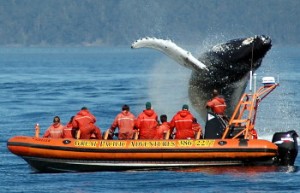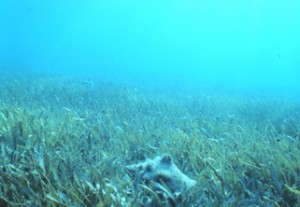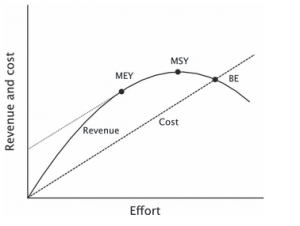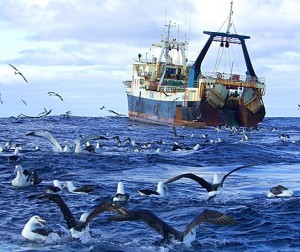 The Marine Stewardship Council, the fisheries eco-certification taken most seriously by consumers and scientists around the world, is failing to fulfill its promise, write six scientists, including the Sea Around Us Project’s Jennifer Jacquet and Daniel Pauly, in last week’s issue of Nature. Read their opinion piece, Seafood stewardship in crisis, or some of the media coverage, such as Why your sustainable fish may not be as guilt-free as you think at The Independent, Scientists criticize system of certifying fisheries at The New York Times Green Blog, or Sustainability certification fails to protect environment: report in the Vancouver Sun.
The Marine Stewardship Council, the fisheries eco-certification taken most seriously by consumers and scientists around the world, is failing to fulfill its promise, write six scientists, including the Sea Around Us Project’s Jennifer Jacquet and Daniel Pauly, in last week’s issue of Nature. Read their opinion piece, Seafood stewardship in crisis, or some of the media coverage, such as Why your sustainable fish may not be as guilt-free as you think at The Independent, Scientists criticize system of certifying fisheries at The New York Times Green Blog, or Sustainability certification fails to protect environment: report in the Vancouver Sun.
Category: New Research
Whale Watching: Worth a Lot
 A new study by authors from the Fisheries Economics Research Unit and the Sea Around Us Project shows that whale watching is a booming industry and a good alternative to whaling. Based on ecological and socio-economic criteria, whale watching could generate an additional US$413 million in yearly revenue, supporting 5,700 jobs. Together with current global estimates, this would bring the total potential for the whale watching industry to over US$2.5 billion in yearly revenue and about 19,000 jobs around the world. The research was covered widely during the IWC meeting. Read, for instance, this piece at Discovery News.
A new study by authors from the Fisheries Economics Research Unit and the Sea Around Us Project shows that whale watching is a booming industry and a good alternative to whaling. Based on ecological and socio-economic criteria, whale watching could generate an additional US$413 million in yearly revenue, supporting 5,700 jobs. Together with current global estimates, this would bring the total potential for the whale watching industry to over US$2.5 billion in yearly revenue and about 19,000 jobs around the world. The research was covered widely during the IWC meeting. Read, for instance, this piece at Discovery News.
Reference: A.M. Cisneros-Montemayor, U.R. Sumaila , K. Kaschner , D. Pauly (in press) The global potential for whale watching. Marine Policy.
Biodiversity in Trouble
 Sea Around Us Project members Daniel Pauly and Reg Watson contributed to a recent paper in Science that shows failure to achieve reductions in biodiversity loss by 2010 at outlined by the 2002 Convention on Biological Diversity (CBD). Most indicators of biodiversity show further declines while indicators of pressure, including spatial expansion of fisheries, show increases.
Sea Around Us Project members Daniel Pauly and Reg Watson contributed to a recent paper in Science that shows failure to achieve reductions in biodiversity loss by 2010 at outlined by the 2002 Convention on Biological Diversity (CBD). Most indicators of biodiversity show further declines while indicators of pressure, including spatial expansion of fisheries, show increases.
MEY=MSY
 When one considers all the extra value generated in a fishery such as processing, distribution and marketing of fish products, higher fisheries quotas make more sense, according to a new paper titled MEY=MSY by Villy Christensen published in Fish and Fisheries. For more than 50 years, it has been generally accepted that the fishing sector stood to gain from managing fisheries at the effort level producing maximum economic yield (MEY) rather than maximum sustainable yield (MSY), which occurs at a higher effort level. “If operating at the lower MEY level would result in so much higher profit to the individual boats and to the fishing sector while maintaining catches nearly at MSY why don’t they?” asks Christensen in the paper. He explains that MEY was built on the assumption that only the revenue and cost structure for the fishing fleet were considered. Christensen points out that when processing, distribution and marketing of fish products are taken into account, there are more profits to be gained, which in turn makes MSY — and a higher fishing effort — the more appropriate target for fisheries.
When one considers all the extra value generated in a fishery such as processing, distribution and marketing of fish products, higher fisheries quotas make more sense, according to a new paper titled MEY=MSY by Villy Christensen published in Fish and Fisheries. For more than 50 years, it has been generally accepted that the fishing sector stood to gain from managing fisheries at the effort level producing maximum economic yield (MEY) rather than maximum sustainable yield (MSY), which occurs at a higher effort level. “If operating at the lower MEY level would result in so much higher profit to the individual boats and to the fishing sector while maintaining catches nearly at MSY why don’t they?” asks Christensen in the paper. He explains that MEY was built on the assumption that only the revenue and cost structure for the fishing fleet were considered. Christensen points out that when processing, distribution and marketing of fish products are taken into account, there are more profits to be gained, which in turn makes MSY — and a higher fishing effort — the more appropriate target for fisheries.
High Seas Fleet Kept Afloat with Subsidies
 High seas bottom trawlers catch some of the tastiest fish (think Orange roughy, rockfish, and Patagonian toothfish), which are also some of the most vulnerable and overfished species because they grow and mature so slowly. A new study shows that this type of overfishing continues because the 200-strong trawling fleet is kept afloat with government money.
High seas bottom trawlers catch some of the tastiest fish (think Orange roughy, rockfish, and Patagonian toothfish), which are also some of the most vulnerable and overfished species because they grow and mature so slowly. A new study shows that this type of overfishing continues because the 200-strong trawling fleet is kept afloat with government money.
Several members of the Sea Around Us Project led by fisheries economist Rashid Sumaila estimated bottom trawl fleets operating in the high seas, i.e., outside of the Exclusive Economic Zones of maritime countries, receive an estimated US$152 million per year in fisheries subsides, which is 25% of the total landed value of the fish. The profit achieved by this vessel group is normally not more than 10% of landed value, which means that without subsidies, the bulk of the world’s bottom trawl fleet operating in the high seas will be operating at a loss, and unable to fish, thereby reducing the current threat to deep-sea and high seas fish stocks. The study is titled Subsidies to high seas bottom trawl fleets and the sustainability of deep-sea demersal fish stocks and was published online this month in the journal Marine Policy.

